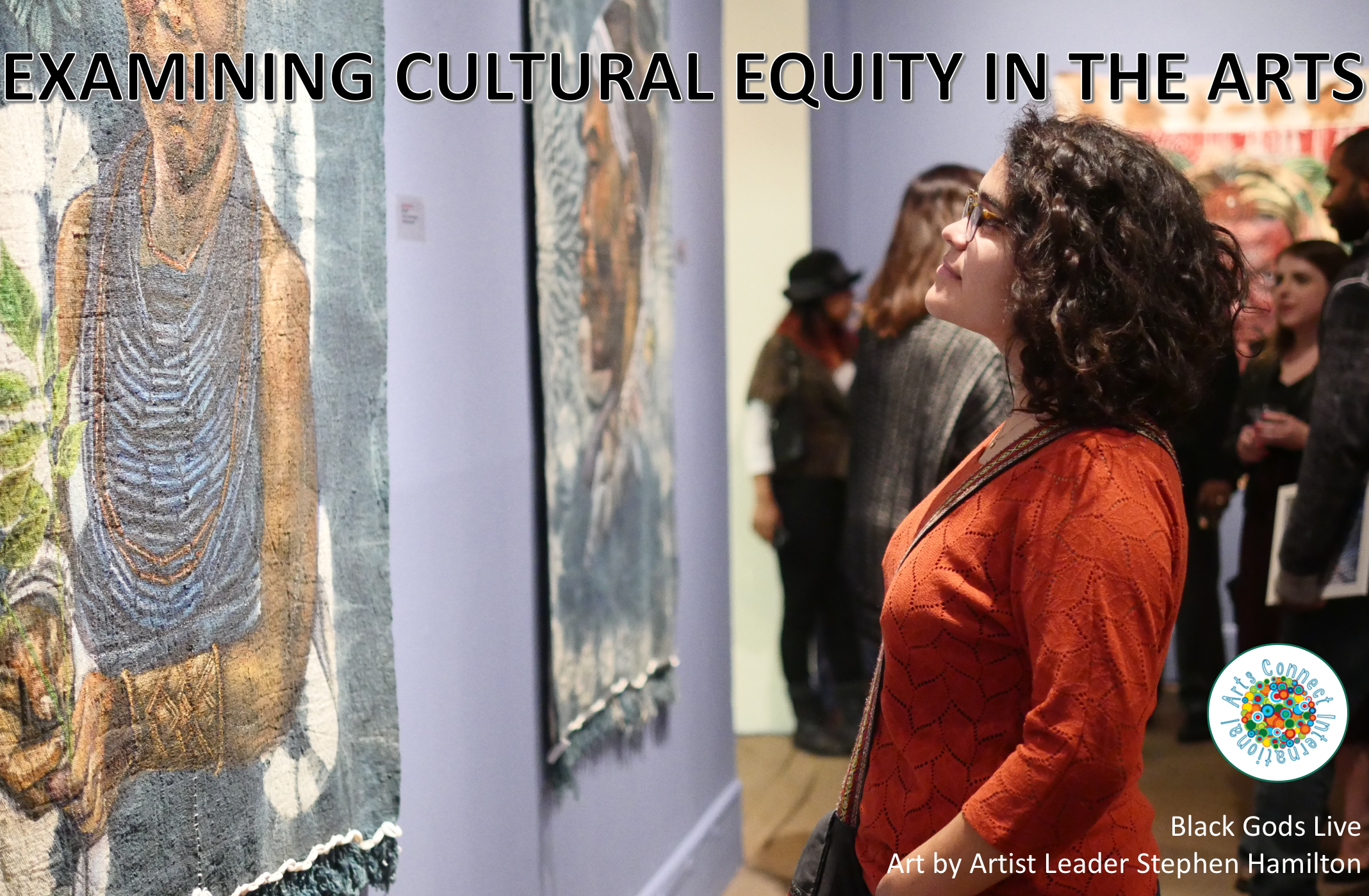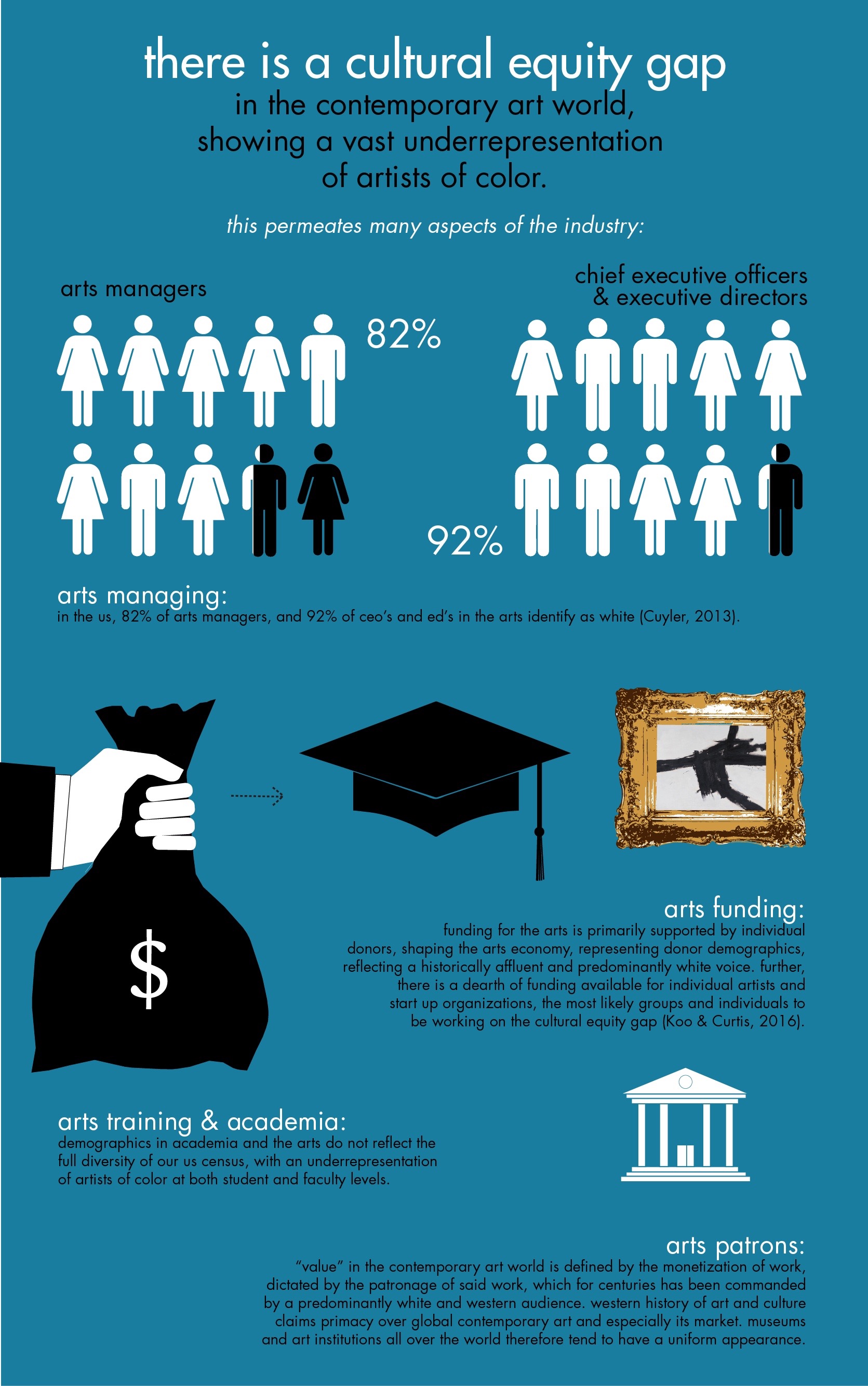
Black Gods Live Arts by Artist Leader Stephen Hamilton
The Arts in America suffer from a “cultural equity gap” -- institutional and systemic racism within arts leadership, and access to the arts. For example, a Grantmakers in the Arts study on arts managers across the U.S. found that 86 percent of all respondents, and 92 percent of CEOs, self-identified as white (Cuyler, 2015). This gap is reflected throughout the arts world, in academia, artist sales, and donor and foundation demographics and priorities.

Photo Credit: Kimberly Curhan, via ACI's website (Arts Connect International, 2017)
Americans for the Arts published a statement on cultural equity, defining it as:
… embodying the values, policies, and practices that ensure that all people -- including but not limited to those who have been historically underrepresented based on race/ethnicity, age, disability, sexual orientation, gender, gender identity, socioeconomic status, geography, citizenship status, or religion… -- are represented in the development of arts policy; the support of artists; the nurturing of accessible, thriving venues for expression; and the fair distribution of programmatic, financial, and informational resources (Americans for the Arts, 2016).
This statement is a seminal step, as it names the various intersectional identities (Crenshaw, 1991) of stakeholders historically underrepresented in the field. Essentially, there is inherent inequity embedded in the Eurocentric arts industry -- a deep history of discrimination and inaccessibility -- which is tied to colonialism and capitalist definitions of success and value (Blackwood, 2014).
Focused on closing the cultural equity gap, Arts Connect International (ACI); a Boston-based non-profit, has become an ‘equity incubator’ focused on creating community-contextualized change through four social impact areas: 1.) leadership development, 2.) community programming, 3.) consulting, and 4.) research. Together these four areas leverage current capabilities and commitments that help close the equity gap in the arts.
Leadership development includes: international entrepreneurial artist residencies designed for, and by, arts leaders focused on social change, artist training institutes focused on core industry skill sets -- akin to a mini MBA, and arts leader retreats that are focused on, and facilitated by, arts leaders of color. All of ACI’s leadership development training is focused on emerging and established arts leaders of color. ACI is very invested in models of leadership development which incorporate a cultural and an economic lens of change. This dual focus places the work as both community-contextualized and economically relevant, positioning arts leaders to have holistic skill sets and economic empowerment.
In support of leadership development, ACI runs a series of community facing programs including symposiums, large-scale conferences, community pop-up events, and partnered events with other local and international organizations. This past year ACI presented workshops and/or speaking engagements at: Tufts University, UMass Boston, Harvard University, Boston Arts Academy, Boston University, and Lesley University, amongst others. In 2016, the Symposium on Art for Cultural Inclusion, co-hosted by the School for Global Inclusion and Social Development at UMass Boston, brought together more than 300 community members and featured more than 30 local partners. Smaller community events include pop-ups with partners like Bernstein Wealth Management with artistic installations in their board room, and ArtBars with partners like Aeronaut Brewing Company, ArtWeek Boston, and VSA Massachusetts.
ACI’s consulting work engages university, non-profit, and for-profit partners to run diagnostics, trainings, facilitated workshops, and artistic offerings aimed at building more inclusive and equitable practices in, and with, said institutional partners. Each consulting engagement ACI takes on is unique in model and execution, with the through thread of artistic approaches. For example, the founder just returned from work with WSMC 90.5 FM Classical Radio in Chattanooga Tennessee where she examined funding for the arts in their local landscape and shared research findings in a sector-wide dialogue around cultural equity in their community.
ACI is rising as a thought leader in research focused on equity in the arts sector. In the summer of 2017, ACI launched an ‘influencer’ study, aimed at understanding current arts leaders’ perceptions and knowledge surrounding the cultural equity gap, as well as motivations to eradicate said gap. In the spring of 2018, ACI will launch a second phase of the study focused on the perceptions and knowledge of artist leaders of color surrounding the cultural equity gap, as well as barriers to access for positions of power in the arts world. This innovative research has produced significant insights through both quantitative and qualitative data to support the industry in identifying: barriers to access, aspects of language used, levers for change, and community partners prime to engage in said equity work. This body of knowledge is essential for systems change, the ultimate goal of ACI’s work. The work has been presented at: University of Massachusetts Boston, Southern Adventist University, Mayo Clinic’s Conference on Arts and Humanities, and the Alliance for Arts in Research Universities, among others.
ACI differentiates itself through its systems oriented approach to equity. Working as an equity incubator, ACI transcends traditional programming to focus on the alignment of community partners to enact social change. ACI has created an articulated blueprint of cultural equity in the U.S. arts landscape, providing industry leaders with a roadmap for discussing barriers to access and levers for change. Given that this work must be community contextualized, ACI focuses on applying a Universal Design for Learning (UDL) lens, focused on creating multiple means for representation, expression, and engagement, both within, and for, each community they work with (CAST, 2017).
Scaling for ACI could take many forms. The team has visions of creating chapters, or hubs, of ‘equity incubators’ across the nation with teams of equity leaders in each chapter. ACI dreams of each major U.S. city having a ‘Cultural Equity Plan’ with detailed and measurable markers to track and actualize building equity in their respective arts landscapes. ACI dreams of expanding their national conference to include more than 500 thought leaders coming together to focus on building racial and cultural equity. ACI also envisions expanding its artist leader programs and residencies reaching more arts leaders across the nation, partnering with various civil sector partners to bring artistic visions of equity to our civil society and private sectors, and building capacity through, and in, the arts. ACI intends to continue to produce the empirical research that the field desperately needs to envision, and advocate for, a more equitable landscape and future of our arts ecosystem.
Works Cited
Cuyler, Antonio C. "An Exploratory Study of Demographic Diversity in the Arts Management Workforce." Grantmakers in the Arts. N.p., Fall 2015. Web. 27 Oct. 2017.
Crenshaw, Kimberle. "Mapping the margins: Intersectionality, identity politics, and violence against women of color." Stanford law review (1991): 1241-1299.
Blackwood, Andria, and David Purcell. "Curating inequality: The link between cultural reproduction and race in the visual arts." Sociological Inquiry 84.2 (2014): 238-263.
"Until Learning Has No Limits." CAST: Home. N.p., 03 Oct. 2017. Web. 27 Oct. 2017.
"Statement on Cultural Equity." Americans for the Arts. N.p., 26 Oct. 2016. Web. 27 Oct. 2017.


